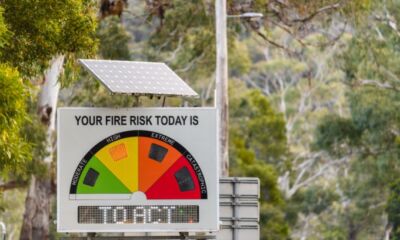Fire insurance cover for bushfires & house fires
Home insurance is designed to provide financial assistance if your home is damaged in certain circumstances, such as by fire. We take a look at what’s covered and the options to consider when it comes to bushfire insurance.

Home insurance is designed to provide financial assistance if your home is damaged in certain circumstances, such as by fire. We take a look at what’s covered and the options to consider when it comes to bushfire insurance.
KEY POINTS:
- For people looking to cover both home and contents from fire damage or loss, most insurers offer a combined insurance policy.
- Having sufficient bushfire insurance could make a huge financial difference in the recovery process.
- Read your policy’s Product Disclosure Statement (PDS) or get in touch with your insurance provider for more information.
Fire is an ever-present risk to homes in Australia. This could be in the form of fires that start inside the house or from outside it, such as bushfires.
Does your home insurance include fire protection?
At the time of writing, all home and contents insurance policies on Canstar’s database include, as standard, a level of financial cover for loss or damage caused by fire, including bushfires and house fires.
A portion of the policies on our database also cover damage caused by heat, ash, soot or smoke, when your home or contents have not caught on fire.
While you may find your insurance does provide a level of cover for fire, it could still be worth checking your policy’s Product Disclosure Statement (PDS) or contacting your insurance provider directly to determine what types of fires are included and if any exclusions or waiting periods apply.
For example, different providers will likely have different definitions of what they consider to be fire damage. This means that while one provider will cover most damage caused by a bushfire, another insurer might only cover damage caused by the flames of the fire and therefore not cover water or smoke damage caused as a result of a bushfire.
What insurance is available for fire damage?
Home insurance
If you want to insure your home building, outbuildings or any permanent fixtures from damage or loss caused by a fire, then you may want to consider home insurance. This type of insurance is typically only available to homeowners.
For those wanting to protect their contents while renting, it may be worth considering renters insurance.
Depending on the policy and level of cover chosen, home insurance may include cover for:
- Repairing or replacing your home or permanent fixtures
- Demolition and removal of debris
- Temporary accommodation while your home is unliveable
- Professional fees, such as for architects or surveyors.
Read your policy’s PDS or get in touch with your insurance provider for more information about what is included in the cover and any exclusions that apply.
Contents insurance
If you want to insure your personal possessions such as furniture, appliances and electronics from damage or loss from a fire, then you may want to consider contents insurance.
Depending on the policy and level of cover chosen, this type of insurance may include cover for:
- The repair or replacement of your belongings
- Removal of your damaged items
- Spoilage of perishable food or medicine (up to certain benefit limits)
- Damage to or loss of guests’ personal possessions while they are visiting your property when the fire occurred (up to certain benefit limits)
- Payment for moving or storage fees for your undamaged contents if a fire makes your home unliveable.
Read your policy’s PDS or contact your insurance provider for more information about what is included in the cover and any exclusions that may apply.
Home and contents insurance
For people looking to cover both home and contents from fire damage or loss, most insurers offer a combined insurance policy. Check the policy’s PDS for a list of inclusions and exclusions associated with a combined policy.
What is not covered under a home insurance policy?
There are a range of exclusions that may apply to your home and contents insurance when it comes to bushfire insurance and house fire cover. Depending on your policy, these may include loss or damage arising from:
- Heat, ash, soot and smoke when your home or contents have not caught on fire, unless it’s caused by a burning building within a certain distance of your home
- Electrical arcing, scorching, or melting where there were no flames, unless a fire spreads from the initial burn spot
- Deliberate, malicious or criminal acts carried out by the policy holder and/or family members, or by guests to the house.
There may also be exclusions surrounding items which are designed to be exposed to heat, such as cooking appliances or home heaters. If these items are damaged or destroyed during normal use, then cover may not be available to replace or repair them.
But if a fire starts from these items and that fire damages other items in your home or the home itself, then your insurance may provide a level of cover. Check your policy’s PDS or contact your insurance provider directly for more information.
Is there a waiting period?
Most home and contents insurers include a waiting period, usually around 72 hours, from when you first take out the insurance policy to when you can make a claim, potentially leaving you unprotected if you were impacted by fire in this timeframe. Check with your provider to see if a waiting period applies.
What types of home and contents insurance cover are available?
There are two types of home and contents insurance you can choose from—sum-insured cover and total replacement cover.
1. Sum-insured cover
Most insurers will operate on a sum-insured model. These policies will cover damage to or replacement of your home and/or contents from fire up to a fixed value, set by you and your insurer.
In the event of a total loss from a bushfire, you may be left underinsured if the agreed amount does not adequately cover the cost of rebuilding or replacing your home and contents. It may be worth checking your insured amount to see if it’s relevant to today’s prices.
Some insurers may also offer extended replacement cover, which will add a certain percentage of payment above the sum-insured amount. This may range from 10% to 30%. Extended replacement cover may be offered as an inclusion under your sum-insured policy, or as an optional extra for an increased premium.
2. Total replacement cover
These policies will typically cover the estimated costs to repair, rebuild or restore your home or contents to the state they were in before the damage or loss occurred from fire. To determine the sum owed to rebuild or repair, your insurer will typically need to do a full assessment of the damage or loss that has occurred. This type of cover generally carries a higher premium than a sum-insured policy.
How to make sure you have adequate fire cover
Having sufficient house fire and bushfire insurance could make a huge financial difference in the recovery process if your home and contents are damaged or destroyed by fire. To help ensure you have adequate fire cover, it may be worth considering the following:
- If you have a sum-insured policy, check if the amount covered matches the value of your assets. To help in valuing your home and contents, consider using an online calculator, or contacting a professional valuer for your property or items. You can also complete an inventory of your contents by doing a room-by-room evaluation.
- Carefully read your policy’s PDS to see what is covered and what exclusions apply. You can also speak to your provider if there is any part of the policy you don’t understand.
- If you think you may be living in a bushfire-prone area, check to see what building requirements are needed for your home in the event you need to rebuild, and consider factoring these costs into your policy.
- Shop around to find a policy that best suits your circumstances.
You can compare home insurance policies using Canstar’s comparison tables. These tables also allow you to filter for policies that provide coverage for fire damage, as well as damage caused by smoke or soot. It’s important to read all relevant policy documentation, such as the Product Disclosure Statement (PDS) and Target Market Determination (TMD), for any policy you are considering.
Reducing the risk of fire damage
You may be able to reduce the risk or impact of fire damage to your home by considering the following:
- Install and maintain smoke alarms so when there is a fire at your home you can notify authorities immediately and evacuate the premises.
- Keep gas and electrical infrastructure and appliances in working order.
- Follow safety advice, such as never leaving candles or anything with an open flame unattended, being careful around heaters and cooking appliances, turning the power off to appliances when they are not in use, and ensuring cigarettes are extinguished properly.
- Prepare your home against bushfires, including cleaning out your gutters, sealing around doors and windows, maintaining your garden, storing fuel and other combustibles away from the home, or adding a sprinkler system to your gutters.
- Follow state or territory building standards/requirements when renovating or building your home in bushfire-prone areas.
To help protect you and those who live in your home, it may also be worth creating (and rehearsing) a fire evacuation plan and a bushfire survival plan.
In a bushfire, it’s also important to follow the advice of your local authorities before deciding whether to stay and defend your property or to evacuate.
Can I get cover if I live in a bushfire-prone area?
If you are living in a bushfire-prone area, such as near coastal scrub, rural grasslands and paddocks or in dense bushland, you could still get bushfire insurance under a home and contents insurance policy, although there may be some additional considerations when assessing your options:
-
Change to building codes
In 2010, following the deadly Black Saturday bushfires the year before, the national Building Code of Australia was amended, and several states followed suit by giving effect to these amendments in legislation.
Properties in at-risk areas now have Bushfire Attack Level (BAL) ratings and must be built using specific designs and materials, such as gutter guards and window shutters. These requirements can significantly increase the cost to rebuild your home if it’s lost in a fire. So, if you live in a bushfire-prone area, you may need to insure your home for more than its current price to account for the cost of implementing these building requirements.
To do this you could consider a total replacement policy, or if available, add extended replacement cover to your sum-insured policy. Check with your insurance provider and your state or territory building approvals authority for more information.
-
Risk of increased premiums
Most insurers will factor in where your home is located when calculating your premium. Because living in a bushfire-prone area increases your risk of damage or loss from a fire, this will likely increase the premium you’re charged.
If you’re not sure if your home is in a bushfire-prone area, check with your rural or regional fire service, or your local council or state/territory government for details. Your provider may also be able to help you.
What to do when making a bushfire claim
If your home or contents are damaged or destroyed by a bushfire, contact your insurance company in the first instance to seek advice about the claims process and avoid doing any repairs unless you have written permission from your insurer to do so.
It’s also a good idea to take photos of any damaged contents or property (when it is safe to do so) to use as evidence for your claim before you remove or throw them out.
Also try to provide your insurer with as much information as you can regarding what’s been lost or damaged from the fire, and answer any questions they may have.
 24/7 claims
24/7 claims
 Online discount
Online discount
 New for old
New for old
 24/7 claims
24/7 claims
 New for old
New for old
 24/7 claims
24/7 claims
 Online discount
Online discount
 New for old
New for old
 24/7 claims
24/7 claims
 New for old
New for old
 24/7 claims
24/7 claims
 Online discount
Online discount
 New for old
New for old
Canstar may earn a fee for referrals from its website tables, and from Sponsorship or Promotion of certain products. Fees payable by product providers for referrals and Sponsorship or Promotion may vary between providers, website position, and revenue model. Sponsorship or Promotion fees may be higher than referral fees. Sponsored or Promotion products are clearly disclosed as such on website pages. They may appear in a number of areas of the website such as in comparison tables, on hub pages and in articles. Sponsored or Promotion products may be displayed in a fixed position in a table, regardless of the product’s rating, price or other attributes. The table position of a Sponsored or Promoted product does not indicate any ranking or rating by Canstar. For more information please see How We Get Paid.
Cover image source: myphotobank.com.au/Shutterstock.com
This article was reviewed by our Finance Editor Jessica Pridmore before it was updated, as part of our fact-checking process.

- Does your home insurance include fire protection?
- What insurance is available for fire damage?
- What is not covered under a home insurance policy?
- Is there a waiting period?
- What types of home and contents insurance cover are available?
- How to make sure you have adequate fire cover
- Reducing the risk of fire damage
- Can I get cover if I live in a bushfire-prone area?
- What to do when making a bushfire claim
 24/7 claims
24/7 claims
 Online discount
Online discount
 New for old
New for old
Try our Home Insurance comparison tool to instantly compare Canstar expert rated options.






